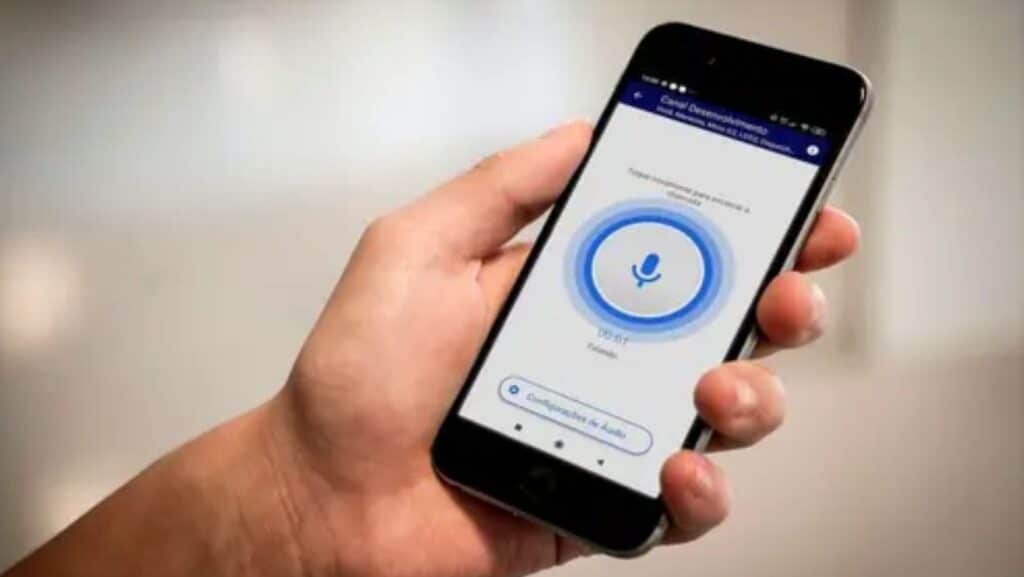Radio communicator operations began in the 20th century, which at the time started a trend with the Nextel company. Precisely in 1987, the push to talk over cellular service was launched, where consumers could have communication without needing the radio communicator itself, but obtaining the same dynamism of a radio communicator using a cell phone.
What differs from today is that, at that time, it was a very specific cell phone with very particular technology. Over time, it became obsolete, especially with the arrival of greater data networks, smartphones, and the spread of mobile broadband; push to talk technology then began to emerge, enabling connectivity through any mobile device.
Sumário
Voice as the Interface of the Future
The market is constantly interacting with applications that use voice, from commands in various electronic devices. It’s a trend that’s moving from the personal field toward the corporate world.
In the private security market, it’s not common for workers to perform their duties with their heads down, looking at a cell phone screen, so constantly looking at messages is neither recommended nor safe for the profession. Therefore, the focus on voice is greater and more necessary, being a useful technology that doesn’t impact the quality of service in the security sector.
When talking about the future, we are prioritizing voice over text. Interacting with machines using voice as the interface of the future is much more challenging, it’s like imagining a movie where you just speak and things happen. Therefore, voice automation as an interface is a major trend in the sector.
Read more about voice as the interface of the future at the following link: https://biptt.com.br/blog/a-voz-como-a-interface-do-futuro
How it Works in Practice
With just a few clicks on a smartphone, it’s possible to provide a range of options and services to use voice as automation in task execution, offering more security and efficiency to operations. Some offerings like GPS and gyroscope are extremely fundamental for knowing precise locations, whether on the road, on a floor, or even in a warehouse. Combined, they serve as a means of automating team management.
For example, in the private security sector, it’s necessary to perform rounds, and knowing if the team is within the established radius is essential. If they leave this area, an alert is sent directly to their supervisor. The same applies when working with a group of executives who need an escort – it’s possible to create a virtual fence to monitor how the escort is proceeding, and if the route deviates from what was planned, emergency actions can be triggered.
How Does the Usability of this Technology Work on a Smartphone?
A standard smartphone is a conventional phone, where a person makes a call and the other person notices the call and answers it. With push to talk technology, the user doesn’t need to notify that they want to talk to someone; the other person is already on standby. The end-to-end service develops quickly and efficiently.
Security service is an environment that protects lives, where there are often dangerous situations such as robberies or accidents. Therefore, there’s no time to wait for the other person to answer before you can speak; something more agile is needed. The future idea in PTT communication is when this type of perception is put into practice. See below:
If an agent falls, the fall itself can be detected by the smartphone (depending on the model of the device) and automatically, it can also trigger some type of pre-established operational procedure.
Additionally, a smartphone as a phone requires a carrier network to operate, while PTT only needs the P network, an Over The Top (OTT) network. This brings some advantages, such as resource sharing. With the arrival of 5G, the immersion of connectivity is essentially fundamental and desired.
What are the Differences between Radio and Smartphone, and the Advantages?
Security works in a very critical environment, and we still see employees contacting other posts using common calls, which is not recommended. PTT technology is a facilitator for this type of communication. Additionally, the solution is more economical and faster. Dealing with multiple radios involves a lot of logistics, they are expensive, probably budgeted in dollars, which constitutes a major disadvantage for the company.
Since push to talk is software, it’s possible to promote constant improvement. Sound quality is extremely relevant; in case of an emergency event, it’s very important to have clear sound without any type of interference, which is provided by push to talk.
Accessibility is another differentiating factor of push to talk, due to the ease and speed of implementing the technology in the company. Centralization of information is not possible with radios, as a radio is needed for each condominium. With biptt, an instant communication application, it’s possible to have a central station that interacts with all condominiums as well as the team on post.

Another example is the virtual fence, which provides this reality of consolidation in the command center through process automation. If it’s necessary to establish a radius around the condominium and a violation of the delimited limit occurs, the command center will receive an alert at the moment of the event. Soon, a tool will be launched that makes it possible to call the team automatically, without the director of the command desk necessarily doing anything.
Learn more about the virtual fence here: https://biptt.com.br/blog/cerca-virtual-a-mais-nova-ferramenta-tecnologica
The combination of accessibility, economy, and quality gives the manager the possibility to look at the team in a more complete and ready way, given the needs of the services offered within the security sector. Biptt provides technological solutions in the field of instant communication, based on push to talk technology that allows the optimization of business operations, especially in the private security sector.
- Text based on the Inasep em Foco Podcast, episode Push to talk 2.0 Communication Intelligence for private security teams. To listen, click on the link https://open.spotify.com/episode/5wnqJV6JZSmqOQs9McAPZF?si=7a75b437e76446e1




